 |
|

|
 |
TABLE of CONTENTS
 |
NTSB cites design error, other factors as cause of I-35W bridge collapse |
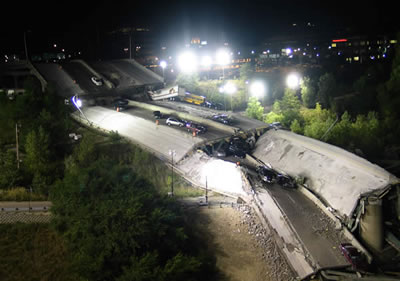
The I-35W bridge glows in the early morning darkness of Aug. 2, 2007, just hours after the structure collapsed into the Mississippi River in Minneapolis. On Nov. 14, 2008, the National Transportation Safety Board released the results of its 16-month investigation saying that the probable cause of the accident was a 40-year-old design error compounded by other factors. Photo by Kent Barnard |
Late last week the National Transportation Safety Board concluded its investigation into the cause of the Interstate 35W Bridge collapse and made recommendations for changes in industry practice to prevent a similar tragedy from occurring on the nation’s other bridges.
During a two-day public hearing that began Thursday, Nov. 13, the NTSB cited an error in the original design of the gusset plates 40 years ago as the probable cause of the collapse. The gusset plates failed under a combination of substantial increases in the weight of the bridge resulting from previous modifications, and traffic and concentrated construction loads on the bridge on the day of the collapse, according to the NTSB.
The board cited contributing factors, including the failure of Sverdrup & Parcel’s (the bridge designers) quality control procedures to ensure that the appropriate main truss gusset plate calculations were performed for the bridge, as well as the inadequate design review in 1965 by federal and state transportation officials.
Another contributing factor the board found was the accepted practice among federal and state transportation officials of giving inadequate attention to gusset plates during inspections for conditions of distortion, such as bowing, and of excluding gusset plates in load rating analyses.
“The Minnesota Department of Transportation appreciates the thorough investigation that the NTSB undertook during the past 16 months, and we respect the professional manner in which the NTSB investigative staff performed this very difficult assignment,” Tom Sorel, Mn/DOT commissioner, said last week at the conclusion of the hearing in Washington, D.C.
“It was critical to have a definitive and complete review of the accident and history of the bridge. Only through such a process can we learn and make improvements,” he said.
As the NTSB released information throughout the last year, Mn/DOT took actions in response to the board’s findings, including:
- Requiring peer review of major bridge designs – Mn/DOT implemented a policy requiring a peer review of the design of major bridges by an independent consultant. The new I-35W Bridge in Minneapolis that opened in September included a peer review. Future replacements such as the Hastings Bridge, Lafayette Bridge in St. Paul and others will require a similar review.
- Reviewing gusset plate designs on Mn/DOT bridges – In July 2008, Mn/DOT completed the review of all truss bridges on the state system and confirmed that the original design of the gusset plates and other bridge members met design requirements. The deficiencies that existed in the original I-35W design were not present in other bridges. Mn/DOT also reviewed the condition of these gusset plates in the field. The reviews that the agency conducted exceeded NTSB recommendations. Gusset plates on three bridges—Blatnik Bridge in Duluth, the Winona Bridge and the Hastings Bridge—were strengthened after deficiencies were found from corrosion or added weight to the bridge. These bridges were restored to the full safety factor required. The Desoto Bridge in St. Cloud, upon field inspection, was found to have several bent gusset plates. Mn/DOT decided to accelerate the already planned replacement of the Desoto Bridge to better coordinate with other road construction projects in St. Cloud.
“The actions we have taken reflect our commitment to improve our processes and protect the safety of the public,” Sorel said. “The loss of 13 people and injury of so many others will forever remain in our thoughts as we perform our mission to deliver transportation services to the state of Minnesota.”
Sorel said that during the past year, Mn/DOT has taken additional actions that address the Nov. 14 NTSB recommendations for bridge owners.
“In addition to visual inspection, Mn/DOT is routinely using non-destructive technology to assess bridge condition, and adding bridge inspection staff for fracture critical bridges,” he said. “Furthermore, the several recommendations on bridge load rating practices have been adopted through actions taken over the last year.”
The Federal Highway Administration and American Association of State Highway and Transportation Officials will be reviewing the NTSB recommendations for adoption nationwide.
For links to the NTSB report and recommendations, Mn/DOT’s response and other information about the I-35W bridge collapse, see http://www.dot.state.mn.us/i35wbridge/index.html.
For an update on Mn/DOT’s review of truss bridges, see http://www.dot.state.mn.us/i35wbridge/statewide_inspection.html.
|
 |
|

|
 |
TABLE of CONTENTS
 |
Settlement reached on Wakota Bridge design issues |
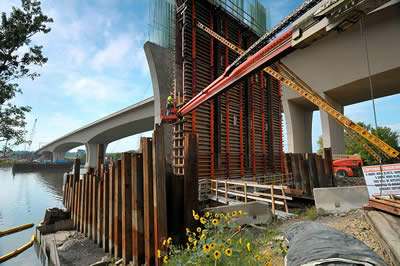
Work continues on the Interstate 494 Wakota bridge in the southeast Twin Cities metro area. Seen here in September, the structure is expected to be completed in 2010. Photo by David Gonzalez |
The state will receive $20 million in a settlement with HNTB Corp., the Kansas City-based designer of the Wakota Bridge project that carries Interstate 494 over the Mississippi River between South St. Paul and Newport.
The settlement, reached with the assistance of neutral third-party mediators, relates to the additional costs incurred by Mn/DOT on the project.
“The settlement with HNTB is a fair and reasonable resolution to this matter,” said Khani Sahebjam, deputy commissioner and chief engineer. “It allows us to avoid costly and time-consuming litigation so we can continue working on other transportation matters of importance to Minnesota.”
In 2004, small cracks were found during construction of the westbound span. When Mn/DOT identified a design issue, the westbound span was retro-fitted and the eastbound span was redesigned. The westbound span opened to traffic in 2006 carrying traffic in both directions. When the eastbound span is completed in 2010, the entire bridge will provide five lanes in each direction.
For more information about the Wakota Bridge project, visit http://www.dot.state.mn.us/metro/projects/wakota/.
|
 |
|

|
 |
TABLE of CONTENTS
 |
First UPA project will save time for commuters, improve safety, reduce congestion |
|
By Beth Petrowske, Metro District public affairs coordinator
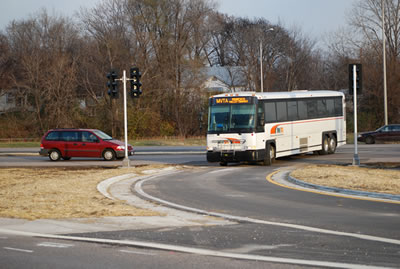
A traffic signal at Hwy 77and Hwy 62 in Minneapolis will stop southbound traffic and allow northbound buses to safely cross over the highway. The signal system includes technology imbedded in the roadway to detect buses. During non-congested times, the traffic signal will remain green and buses will use the Hwy 77 northbound loop to enter westbound Hwy 62. Photo by Beth Petrowske |
Mn/DOT has completed the first of several Urban Partnership Agreement projects designed to reduce congestion in the Twin Cities.
The project improves commute time for transit riders who travel into Minneapolis from the southern suburbs through a bus-only turn lane that connects northbound Hwy 77 to westbound Hwy 62.
The bus-only turn lane allows buses to avoid using the often-congested Hwy 77 northbound loop to westbound Hwy 62 and may shave up to 10 minutes from a typical commute during peak travel times. Signs will be posted to ensure motorists understand that it is for buses only.
The project, completed on Nov. 13, is the first of more than 20 projects funded through the U.S. Department of Transportation’s UPA Program. Minnesota was awarded $133.3 million through the program and will use the funds to reduce congestion on Interstate 35W and Hwy 77 and in downtown Minneapolis. The program includes projects between downtown Minneapolis and the southern suburbs and additional transit service and park-and-ride lots on I-35W in the northern suburbs and on Hwy 77.
More time saving and safety benefits for transit riders
By late 2008, Minnesota Valley Transit buses using this bus-only ramp will incorporate an innovative use of differential global positioning technology to help bus drivers keep buses centered on the bus-only shoulders and assist in precision docking at bus stops.
This project, also funded through UPA, will enable bus drivers using this advanced technology to know precisely where the bus is relative to adjacent lanes. It allows buses to travel safely at higher speeds on the bus-only shoulders in conditions that typically prevent use due to reduced visibility caused by weather or darkness. Transit riders will benefit from this technology with faster, more consistent trips. The differential global positioning technology is being developed by researchers at the University of Minnesota’s Intelligent Transportation Systems Institute.
For more information on UPA, visit the project Web site at http://www.dot.state.mn.us/upa/.
|
 |
|

|
 |
TABLE of CONTENTS
 |
Task force to advise legislators on transportation management, operations strategies |
|
How does Mn/DOT set priorities for spending money? What’s involved with maintaining roads? What are Mn/DOT’s processes for selecting, developing and delivering projects? How do we measure the department’s effectiveness?
These are just a few of the questions facing the Transportation Strategic Management and Operations Task Force, an advisory group established by the 2008 Legislature to find ways for improving state transportation efficiency.
The group, which began meeting in October, includes representatives from Mn/DOT, the Met Council, the Legislature and organized labor, as well as the governor’s representatives from academia, the private sector and construction industry.
Bernie Arseneau, Policy, Safety and Strategic Initiatives Division director, is Mn/DOT’s representative on the task force. Ginny Crowson, director of the Office of External Partnering, provides staff support to the group.
The task force’s focus is on state transportation construction and maintenance projects, and management of state transportation infrastructure. Presentations from Mn/DOT staff to the group have included the core areas of finance and budget; project development; system maintenance and performance measures.
The task force will present its assessment of current practices and recommendations for improvement to the governor and Legislature by Dec. 15. At minimum, the report will include an analysis of the project development process, cost estimation, bidding and award of contracts, contract management, cost overruns and Mn/DOT’s construction project oversight.
For more information about the task force, contact Ginny Crowson, 651-366-4840.
A list of task force members, as well as meeting notes and materials, can be found at http://www.dot.state.mn.us/updates/transportationtaskforce.html. |
 |
|

|
 |
TABLE of CONTENTS
 |
Work begins to repair Transportation Building granite façade |
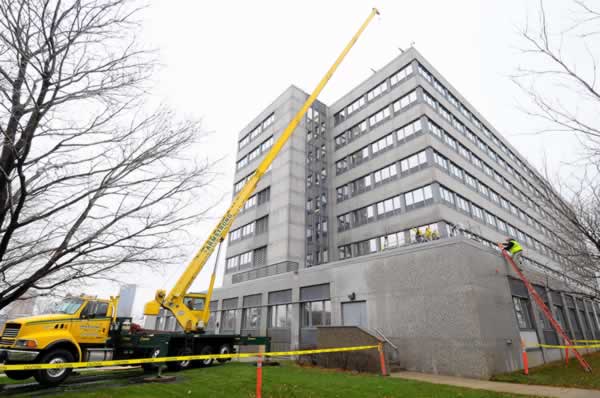
Contractors have begun removing a few of the decorative granite panels from the Transportation Building, the first step in rehabilitating the building’s façade.
The work is required because trapped moisture caused the panels’ steel supports to rust. The project includes removing the panels, replacing the steel supports and doing other maintenance work.
Work currently underway will help determine the full extent of repairs needed and help the contractor schedule its operations.
Full-scale operations will resume in the spring, said Ed Clarke Administrative Services Section manager. Project completion is planned for fall 2009. Photo by David Gonzalez
|
|
 |
|

|
 |
TABLE of CONTENTS
 |
Scott Peterson named as Government Affairs director |
|
Scott Peterson, Financial Management director, was appointed to serve as director of Government Affairs.
He succeeds Betsy Parker, who was appointed to the new position of Mn/DOT’s chief counsel in July.
In his new role, Peterson will shape legislation and coordinate Mn/DOT’s agenda with the Legislature, local government agencies and other policymakers. His office will continue to lead communication with Minnesota’s Congressional delegation.
Peterson’s career with Mn/DOT started in 1995 with the Office of Investment Management. His other positions have included legislative liaison, assistant to the deputy commissioner and, most recently, Financial Management director.
Peterson holds a bachelor’s degree in political science from Dakota Wesleyan University in Mitchell, S.D., and a master’s degree in economics from South Dakota State University, Brookings.
He is native of Woonsocket, S.D.
“Scott’s background includes eight years of management experience, extensive knowledge of transportation policy and finance, as well as broad experience in economic and financial analysis,” said Khani Sahebjam, deputy commissioner.
“He has been actively involved in Mn/DOT legislative activities since the 2000 session,” Sahebjam said. “Scott’s excellent relationships with legislative staff and familiarity with legislative processes will serve Mn/DOT well as he assumes his new role.”
|
 |
|

|
 |
TABLE of CONTENTS
 |
New on the Web: Site will provide information about Minnesota Management & Budget |
|
State employees will have access starting Nov. 24 to the new Web site for Minnesota Management & Budget, the agency formed when the departments of Employee Relations and Finance were merged in April.
The Communications Office Web team and other Webmasters are working to correct links on Mn/DOT’s Web sites. In the meantime, users will be automatically directed to the new MM&B home page, www.mmb.state.mn.us.
For more information, contact the Mn/DOT Web team at: Webteam@dot.state.mn.us.
|
 |
|

|
 |
TABLE of CONTENTS
 |
Videoconference rooms to get new equipment |
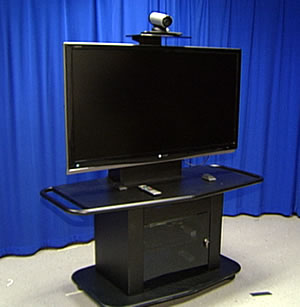
An LCD television like this one will eventually replace the two television units now in-place in the department's videoconference rooms. The images of both the local and remote sites will still be visible to the viewer. Photo by Gary Andrist |
A phased-in replacement of Mn/DOT’s videoconference room equipment—televisions, remote controls, PC connections—will begin in December, starting with the two videoconference rooms in the Central Office Transportation Building.
A schedule for the replacement of other videoconference room sites is still in development.
The primary change employees will see is one larger (LCD) television screen instead of two. The images of both the local and remote sites will still be visible to the viewer, according to Hyline Mamboleo, Office of Information and Technology Services.
In addition, the features on the remote control will remain the same, but be laid out differently. There also will be improved PC connections, which will allow for use of audio from the computer as well as provide for higher screen resolution.
The changeover will require about one day of downtime for installing the new equipment, Mamboleo said.
OITS will be offering several one-hour training sessions for employees on use of the new equipment. Watch for an announcement with more information about training dates and times.
|
 |
|

|
 |
TABLE of CONTENTS
 |
Section of Hwy 71 earns Perpetual Pavement Award |
By Craig Wilkins
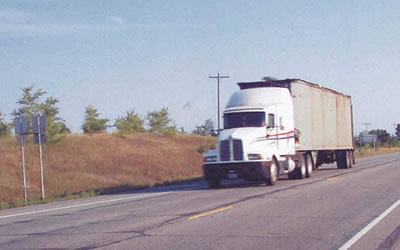
Hwy 71, winner of a 2008 Perpetual Pavement Award from the National Asphalt Pavement Alliance, is seen here in 2007, a mere 37 years after its orignal construction, which included a granular base, aggregate base, an asphalt base course and an asphalt surface course. Photo courtesy of District 8 |
The lasting performance of a section of pavement on Hwy 71 earned honors Nov. 12 from the National Asphalt Pavement Alliance.
The six-mile section extends north from Hwy 9 near New London in Kandiyohi County to Hwy 55, which borders Stearns County.
The alliance presented Mn/DOT with its Perpetual Pavement Award in Chicago during an international conference on warm-mix asphalt pavements.
Built in 1970, the six-mile highway section’s design used a granular base, aggregate base, an asphalt base course and an asphalt surface course totaling 23 inches in depth.
Since then, District 8 added 1.5 inches of asphalt surfacing in 1991. In 2005, two inches of the asphalt surface was milled off and replaced by a four-inch asphalt overlay.
“Even though this pavement has been punished by nearly 40 years of use, motorists are still using the original pavement structure,” said Mike O’Leary, co-chair of the APA. “The extraordinary performance of this pavement is worthy of attention.”
The road is part of the corridor motorists use when traveling in west central Minnesota from Bemidji to Iowa and has withstood the tests of time and traffic, according to Dave Trooien, district engineer at Willmar.
“The methodology used during the road’s construction in 1970 was innovative and has now become an accepted standard,” he said. “The design provides a good foundation on which to build. Using this design to extend pavement life provides many benefits.”
|
 |
|

|
 |
TABLE of CONTENTS
 |
Commissioner responds to “What’s the buzz?” questions |
What’s on employees’ minds these days?
Apparently potential layoffs, staff retention and ways the agency can save money, among other topics that Mn/DOT employees submitted to Commissioner Tom Sorel during the past month via his “ What’s the Buzz?” site on iHUB.
To read the commissioner’s responses, or submit comments or questions of your own, see What’s the Buzz? |
|
 |
|
| |
|



